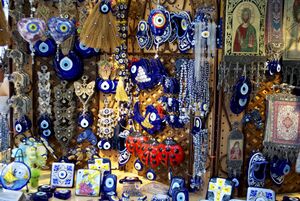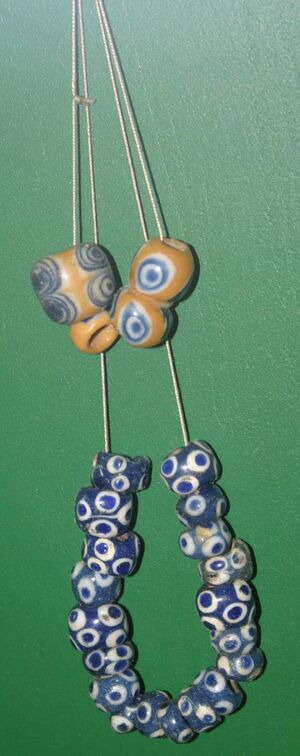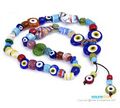نظر (تميمة)

النَظَر (إنگليزية: nazar)، هي تميمة على شكل عين يعتقد أنها تحمي من عين الحسد (أو عين الشيطان). كما يستخدم هذا المصطلح في اللغة الأذرية البنغالية والهندية والكردية والپاشتو والفارسية والپنجابية والتركية والأردو ولغات أخرى.[1] تُعرف في تركيا باسم نظر بونكوغو (مشتقة من بنوكوك، وتعني خرزة، وباليونانية باسم ماتي (أي عين الحسد). أما في الفلكلور الإيراني والفارسي، فتسمى چشم نظر أو نظرقربانی.[2]
It is commonly believed that the evil eye can be given in the guise of a compliment, signifying its connection to the destructive power of envy (for one’s wealth, beauty etc.). Amulets such as the Nazar are used in accordance with common sayings such as "an eye for an eye", where another eye can be used to protect the recipient of the malefic gaze.[3] The evil eye causes its victim to become unwell the next day, unless a protective phrase such as "With the will of God" ("MashAllah" in Arabic) is recited.[4] Among adherents of Hinduism and Islam in South Asia, when a mother observes that her child is being excessively complimented, it is common for them to attempt to neutralize the effects of the evil eye (nazar utarna) by "holding red chillies in one hand and circling the child's head a few times, then burning the chillies."[5][6]
التميمة
يُصنع النظر النموذجي من الزجاج المصنوع يدويًا ويتميز بدوائر متحدة المركز أو أشكال دمعة باللون الأزرق الداكن والأبيض والأزرق الفاتح والأسود، مع حافة صفراء/ذهبية أحياناً.[7]
خرزة العين
خرزة العين هي نوع من فن الزجاج تعتمد على النظر في تركيا.
معرض الصور
نظر معلق على باب غرفة مولد جديد في مستشفى بتركيا.
انظر أيضاً
المصادر
- ^ Khan, Abdul Jamil (2006). Urdu/Hindi: An Artificial Divide: African Heritage, Mesopotamian Roots, Indian Culture & British Colonialism (in الإنجليزية). Algora Publishing. p. 138. ISBN 9780875864389.
Arabic verbs have generated an enormous number of words for Urdu/Hindi as well as Persian. ... The word nazar, meaning eye, or sight, is part of the cultural idiom -- <nazar lag jana>, meaning 'evil eye's effect,' and is used in the whole subcontinent.
- ^ M. Moin: A Persian Dictionary, 3rd edition, p. 4752 (in Persian).
- ^ Dundes, Alan (1992). The evil eye: a casebook. University of Wisconsin Press. ISBN 0-299-13334-6. OCLC 863469680.
- ^ Giger, Joyce Newman (29 January 2016). Transcultural Nursing (in الإنجليزية). Elsevier Health Sciences. p. 351. ISBN 9780323400046.
- ^ Shankar, Vijay N. (20 August 2014). Shadow Boxing with the Gods (in الإنجليزية). Leadstart Publishing. p. 43. ISBN 9789381836804.
- ^ Valsiner, Jaan (2 February 2000). Culture and Human Development (in الإنجليزية). SAGE Publications. p. 182. ISBN 9780761956846.
In Rajastan (India) the treatment of the 'evil eye' includes seven red chilis and some salt circled over the head of the sick child before these are thrown into the hearth.
- ^ Lonely Planet Middle East.Lonely Planet; 6 edition, 2009, p. 559.
المراجع
- Ronald T. Marchese (2005). The Fabric of Life: Cultural Transformations in Turkish Society. pp. 103–107.
وصلات خارجية
 Media related to Nazar amulets at Wikimedia Commons
Media related to Nazar amulets at Wikimedia Commons- "Nazar Amulet – Blue Color Wards Off The Evil Eye According To Ancient Belief". Ancient Pages. 12 March 2018. Retrieved 13 July 2021.






